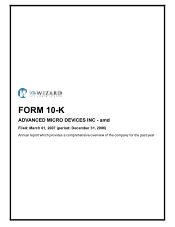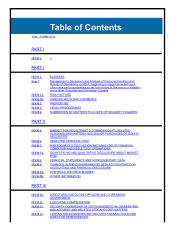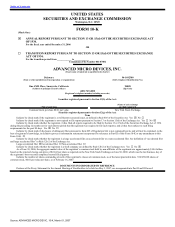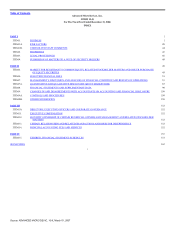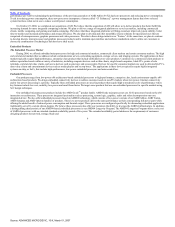AMD 2006 Annual Report Download - page 9
Download and view the complete annual report
Please find page 9 of the 2006 AMD annual report below. You can navigate through the pages in the report by either clicking on the pages listed below, or by using the keyword search tool below to find specific information within the annual report.
Table of Contents
processors offer enhanced overall system performance and efficiency because computing tasks can be spread across two or more processing cores each of which
can execute a task at full speed. Moreover, two or more processor cores packaged together can increase performance of a computer system without greatly
increasing the total amount of power consumed and the total amount of heat emitted. This type of “symmetrical multiprocessing” is effective in both
multi-tasking environments where multiple cores can enable operating systems to prioritize and manage tasks from multiple software applications simultaneously
and also for “multi threaded” software applications where multiple cores can process different parts of the software program, or “threads,” simultaneously
thereby enhancing performance of the application. Businesses and consumers also require computer systems with improved power management technology,
which allows them to reduce the power consumption of their computer systems thereby reducing the total cost of ownership. With the recent release of
Microsoft® Windows Vista ™ and with the proliferation of applications for multimedia and gaming, grid computing and extensive enterprise databases, we
believe the demand for 64-bit computing, multi-core technology and improved power management technology will continue to increase.
Microprocessor Products
We currently offer single-core and dual-core microprocessor products for servers, workstations, notebooks and desktop PCs. Our microprocessors
currently are designed with both 32-bit and 64-bit processing capabilities. We based our microprocessors on the x86 instruction set architecture and most of these
processors are also based on the AMD64 technology platform with direct connect architecture. Direct connect architecture connects an on-chip memory
controller and input/output, or I/O, channels directly to one or more microprocessor cores. For dual-core processors, we integrate two processor cores onto a
single die and each core has its own dedicated cache, which is memory that is located on the semiconductor die. We believe this architecture, and, in particular,
the integrated memory controller, enables substantially higher performance because memory can be accessed more directly rather than traversing a traditional
front-side bus, which results in increased bandwidth and reduced memory latencies. Our processors support HyperTransport™ technology, which is a
high-bandwidth communications interface we initially developed that enables substantially higher performance and supports our I/O virtualization technology. In
designing our processors, we also focus on continuously improving power management technology, or “performance-per-watt.” To that end, we offer processors
that feature AMD PowerNow!™ technology, which we designed to reduce system level energy consumption, with multiple levels of lower clock speed and
voltage states that can significantly reduce processor power consumption during idle times. We design our microprocessors to be compatible with operating
system software such as the Microsoft® Windows® family of operating systems, Linux®, NetWare®, Solaris and UNIX. We also designed the AMD64
architecture to enhance the security of a user’s computing environment by integrating security features that are designed to prevent the spread of certain viruses
when enabled by the anti-virus features of current versions of certain operating systems, including Linux, the Microsoft® Windows® family of operating systems
and Solaris operating systems.
Servers and Workstations. Our microprocessors for servers and workstations consist primarily of our single-core and dual-core AMD Opteron ™
processors. A server is a powerful computer on a network, often with multiple microprocessors working together, that is dedicated to a particular purpose, stores
large amounts of information and performs the critical functions for that purpose. A workstation is essentially a heavy-duty desktop, designed for tasks such as
computer-aided design and digital content creation. We based our AMD Opteron processors for servers and workstations on the AMD64 technology platform,
which extends the industry-standard x86 instruction set architecture to 64-bit computing, and designed them to allow simultaneous 32-bit and 64-bit computing.
These processors can be used in a variety of server applications, including business processing (enterprise resource planning, customer relationship management,
and supply chain management) and business intelligence. They can also be used in workstation applications such as engineering and digital content creation
software and other information technology infrastructure applications such as intensive Web serving and messaging.
4
Source: ADVANCED MICRO DEVIC, 10-K, March 01, 2007

